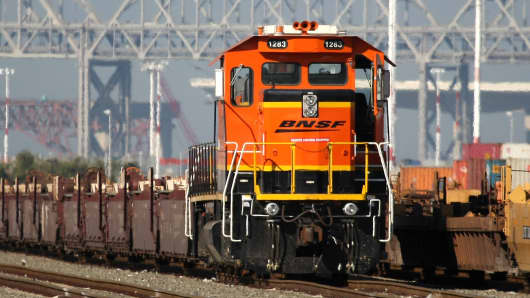With shale oil wells subject to sharp declines after the first year of production, "there is hesitance among producers to come to multi-year deals. That's what a pipeline guy wants," he said.
Meanwhile, delays in projects like the Keystone XL pipeline have forced energy producers to adapt to the immediacy of transporting U.S. crude by rail. This week, Cenovus Energy, a Canadian oil company with several U.S. refineries, announced that it would dramatically increase the amount of oil it ships via train, from 6,000 barrels to 30,000 by the end of 2014.
Pipes "have high barriers to entry, large commitments to make piplines grow, a short list of companies that can back them and a long lead time to construct them" said Richard Dembicki, Cenovus' director of crude oil marketing, in an interview.
By contrast, freight trains "are easier to contract usage and expand…and have the ability to target higher value markets," he said.
Still, both methods of transport have their uses, Dembicki added. "We think of rail as being very complimentary to pipe, that's why we're creating that expanded capability."
A modestly sized pipeline can transport 150,000 barrels per day, according to the Association of Oil Pipe Lines. That volume would require a minimum of 225 rail cars to transport, or 750 tanker trucks, the AOPL says on its website. The association also touts the "environmental and safety benefits" of pipelines – which carry more than 11.3 barrels of petroleum a year interstate – including less air pollution, lower spill rates, and lack of congestion on roads and rivers.
"Rail does have short-term benefits, which are flexibility to meet new production locations quickly and their existing rail network in the heartland," John Stoody, AOPL's director of government relations, in an email to CNBC.
"That said, the overall volumes on rail, while growing, are still a small percentage of pipelines," he added. Rail shipments from Canada to the US, Stoody said, are projected to be "only one fourth of the volume carried by a major pipeline like Keystone XL" -- a fraction of the 6.7 million barrels of Canadian oil per day expected by 2030, he added.
The "explosive growth" in U.S. energy production–and the relative attractiveness of rail–has allowed companies like Valero Energy to migrate from port-to-port oil tankers to trains instead, said Bill Day, a Valero spokesman.
"Rail is much more flexible getting supplies from one area to the other," he said. Although he cautioned that pipelines also are useful, Day cited their cost, and lashed out against the "horrific political questions" that hamstring projects like the Keystone XL pipeline.
"With all this new production of U.S. crude, we will need pipelines and rail deliveries," Day said.





